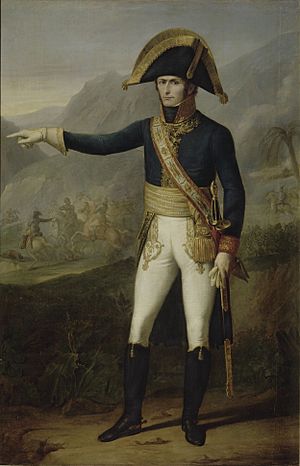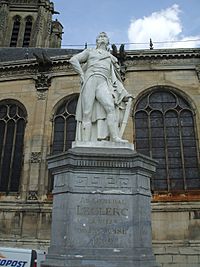Charles Leclerc (general, born 1772) facts for kids
Quick facts for kids
Charles Leclerc
|
|
|---|---|

Portrait by François-Joseph Kinson, 1804
|
|
| Born | 17 March 1772 Pontoise, France |
| Died | 2 November 1802 (aged 30) Tortuga, Saint-Domingue |
| Allegiance | |
| Service/ |
French Army |
| Years of service | 1791–1802 |
| Rank | Général de division |
| Battles/wars | French Revolutionary Wars Saint-Domingue expedition |
Charles Victoire Emmanuel Leclerc (born March 17, 1772 – died November 2, 1802) was a French Army general. He served under the famous leader Napoleon Bonaparte during the time of the French Revolution. Leclerc was also married to Pauline Bonaparte, who was Napoleon's sister.
In 1801, General Leclerc was sent on an important mission to Saint-Domingue (which is now Haiti). He led a large group of soldiers. His goal was to bring the colony back under French control. During this mission, he captured Toussaint Louverture, a key Haitian leader. Sadly, Leclerc died from a disease called yellow fever during this expedition.
Contents
The Life of General Charles Leclerc
Early Military Career (Before 1801)
Charles Leclerc began his military journey in 1791. This was during the French Revolution. He joined the army as a volunteer. He quickly moved up the ranks. He became a sous-lieutenant and then an aide to General Lapoype.
Leclerc was made a captain during the siege of Toulon. Here, he first met and became friends with Napoleon Bonaparte. After this success, he fought in campaigns along the Rhine River. He continued to serve under Napoleon in battles in Italy. He fought at Castiglione della Pescaia and Rivoli. By 1797, he had become a général de brigade.
When Leclerc returned to France, Napoleon offered him his sister Pauline's hand in marriage. They married in 1797. They had one child named Dermide.
Leclerc later became a chief of staff for other generals. He also took part in a French military trip to Ireland in 1798. When Napoleon returned from his trip to Egypt, he made Leclerc a général de division. Leclerc then helped Napoleon in the 18 Brumaire coup d'état in November 1799. This event made Napoleon the leader of France. Leclerc helped by ordering soldiers to enter the meeting room of the Council of Five Hundred.
He was also known for his role in the Rhine campaign and the Battle of Hohenlinden. He was given command of several military divisions.
The Saint-Domingue Expedition
In 1791, enslaved people in the French colony of Saint-Domingue started a rebellion. This was known as the Haitian Revolution. In 1793, slavery was officially ended in Saint-Domingue. A rebel leader named Toussaint Louverture joined the French side. By 1801, Louverture had taken control of the entire island. He even created a new constitution for the colony. This constitution named him governor for life.
Napoleon saw Louverture's new constitution as a challenge to French power. In October 1801, Napoleon chose Leclerc to lead a military mission to Saint-Domingue. Leclerc's secret orders were to remove Louverture's government. He was also told to deport Louverture's officers to France. Napoleon planned to bring back slavery in Saint-Domingue after Louverture was arrested.
Leclerc left France in December 1801. He arrived in Saint-Domingue in February 1802 with about 40,000 troops. He publicly promised that all people in Saint-Domingue were French and free. Leclerc used clever tactics to win over some of Louverture's officers. He promised they would keep their ranks in the French Army. This caused many to leave Louverture's side.
The French army won several battles. They regained control in about three months. Louverture agreed to surrender and retired to his home. However, Leclerc followed Napoleon's secret orders. He arrested Louverture during a meeting. Louverture was sent to France, where he later died in prison in 1803.
Leclerc did not fully disarm Louverture's former officers. After a short time, many of these troops began to leave Leclerc's army. They joined the black and Creole people of the colony. This happened because news spread that slavery had been brought back in another French colony, Guadeloupe. The fear of slavery returning to Saint-Domingue turned many against the French. Leclerc began to execute people he suspected of planning against him.
By October 1802, Leclerc wrote to Napoleon. He felt very sad about his mission. He also suggested harsh actions against the rebels. More black and mixed-race army officers left Leclerc's side. These included important leaders like Jean Jacques Dessalines, Alexandre Pétion, and Henri Christophe.
General Leclerc's Death
In November 1802, General Leclerc died from yellow fever. This disease had already caused many deaths among his soldiers. His wife, Pauline, returned to Europe.
General Rochambeau took over command. His harsh actions made more leaders join the rebel armies. On November 18, 1803, François Capois defeated Rochambeau's forces. Dessalines then declared Haiti's independence on January 1, 1804. Leclerc's body was taken back to France by his wife and buried on his land.
Memorials
There is a statue of Charles Leclerc in Pontoise, France. It shows him in his Napoleonic uniform. The statue is about 3 meters tall. It stands on a stone base with information about him written in gold letters. This statue is next to the city's cathedral. There is also another statue of him by Jean Guillaume Moitte in the Pantheon de Paris.
See also
 In Spanish: Charles Victoire Emmanuel Leclerc para niños
In Spanish: Charles Victoire Emmanuel Leclerc para niños


